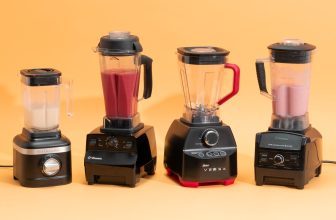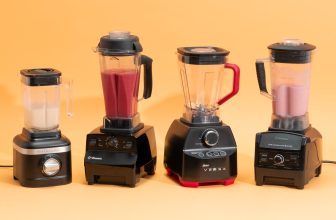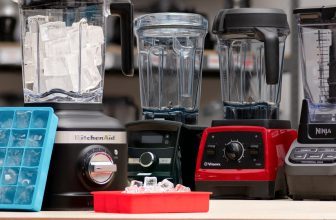As an Amazon Associate I earn from qualifying purchases.
Why Are Blenders Loud
Why Are Blenders Loud? Ever wonder why your blender sounds like a jet engine taking off? The harsh, almost unnerving noise is a common complaint among kitchen gadget enthusiasts. Yet, beneath the cacophony lies an intriguing interplay of physics and engineering.
Blenders are loud primarily due to their robust motors, which can reach speeds of up to 30,000 RPM. This need for power stems from their function: the rapid movement of blades through dense ingredients creates sound pressure waves that are amplified by the device’s structure. Interestingly, newer designs aim to balance efficiency with sound insulation, though truly silent models remain elusive.

Why are blenders loud?
Blenders are loud, and there’s no way around it, mainly due to their powerful motors. These motors spin the blades at incredibly high speeds, sometimes reaching up to 30,000 RPM. This level of power is necessary to cut through tough ingredients like ice and frozen fruits. However, the energy required for this also translates into a significant amount of noise. The rapid blade movement creates sound waves that reverberate inside the blender jar, amplifying the noise.
- POWERFUL 1500-WATT MOTOR: Crush ice, blend frozen fruit, and power through tough ingredients with the 2-horsepower motor, designed for professional results.
Another factor contributing to the noise is the air circulation within the blender. High-speed motors need cooling to function properly. This is why most blenders have built-in fans. As these fans spin, they create additional noise. In many cases, the design of the air vents can further amplify the sound. Changing the cooling mechanism might help reduce some of these noises.
The materials used in making blenders also play a role in how loud they are. Most blender jars are made of hard plastic or glass, both of which can act as sound resonators. This means they can amplify the noise being produced by the motor and blades. Using materials with better sound dampening properties could potentially make blenders quieter. However, this may also affect the durability and effectiveness of the blender.
Lastly, the type of ingredients being blended influences the noise level. Softer ingredients like bananas and berries generate less noise than harder ones like nuts or ice. This is because softer items offer less resistance to the blades. However, many popular recipes call for a mix of hard and soft ingredients, making it challenging to achieve lower noise levels consistently. Thus, while various factors contribute to blender noise, balancing power, efficiency, and sound reduction remains an ongoing challenge for manufacturers.
An Examination of Blender Design
The design of a blender significantly impacts its performance and noise levels. The shape of the blender jar, for example, can influence how ingredients are processed. A narrower base helps ensure that ingredients are pushed towards the blades. This more efficient blending process can reduce noise. However, even slight design alterations may affect how well a blender operates under different conditions.
Blenders often feature a combination of plastic and metal parts. The materials used can affect both the durability and the sound produced. Metal components, while more durable and efficient for cutting, are often louder. Plastics, on the other hand, can absorb some sound but are less robust. The challenge is to find a balance that ensures both functionality and minimal noise.
The layout of the motor and cooling systems is another vital aspect of blender design. Placing the motor at the base helps to stabilize the appliance but can increase vibration. This vibration can then travel through your kitchen countertop, amplifying noise. Improved padding or damping materials might help reduce this issue. Such changes can enhance user experience by decreasing noise without sacrificing power.
Speed settings also play a crucial role. Modern blenders come with multiple speed options, allowing users to choose the appropriate level for different tasks. Lower speeds are generally quieter but may not be sufficient for tougher ingredients. Conversely, higher speeds can blend these ingredients faster but produce more noise. Offering a range of settings helps consumers find a middle ground, balancing efficiency and sound level.
Key Factors Causing Blender Noise
Blender noise primarily stems from the high-speed motors used in these devices. These motors need to rotate the blades extremely fast to crush ice, nuts, and other tough ingredients. This rapid movement generates loud mechanical sounds. The sound then resonates through the blender’s body and jar. Using more efficient, quieter motors could help, but it would likely increase the cost.
Another significant factor is the vibration caused by the blender’s operation. As the motor runs, it often creates vibrations that travel through the countertop. This added vibration amplifies the perceived noise. Anti-vibration pads or a more stable base can help reduce this issue. Many high-end blenders incorporate such features to offer a quieter blending experience.
The materials used in the blender’s construction also play a vital role. Hard plastic and glass jars amplify sound waves generated by the motor and blades. Softer, more sound-absorbent materials could lessen noise but may not be as durable. Manufacturers must balance durability and sound reduction when selecting materials. This decision directly affects how loud or quiet a blender is during operation.
The type of ingredients being blended is another crucial factor. Hard items like nuts and ice produce more noise than softer ingredients like fruits and vegetables. This is because they require more force to break down, which increases the stress on the motor and blades. Using pre-crushed ice or softer foods can help reduce noise levels. However, this may not be convenient for all users, depending on their needs.
The Science Behind the Loud Noise
The loud noise produced by blenders can be explained through the principles of physics. When the blender’s motor spins its blades at high speeds, it generates mechanical energy. This energy needs to go somewhere, and it often turns into sound waves. These sound waves then travel through the air and hit our ears as noise. The higher the speed, the louder the noise tends to be.
The design of the blade assembly also affects noise levels. Blades slicing through hard ingredients like ice or nuts create high-energy impacts. These impacts generate shock waves that travel through the blender jar. Because the jar is usually made of hard plastic or glass, these shock waves get amplified. The result is a louder blending process, especially when crushing hard items.
Airflow and cooling are other scientific elements to consider. Most blenders have built-in fans to cool the motor. As the fans rotate, they create additional air movement and friction. This airflow contributes to the overall noise. Improved cooling designs could potentially reduce this added noise.
Vibration plays a significant role in noise production as well. The motor and blades cause the blender to vibrate, which generates sound. When the blender is placed on a countertop, these vibrations can resonate through the surface. Using anti-vibration pads or mats can help lessen the noise. However, they do not completely eliminate the problem.
The interaction between various parts also matters. For example, loose parts can create rattling noises when the blender is in use. Securing these parts can reduce unwanted sounds. Efficient assembly and quality materials could therefore make a big difference in noise levels. Manufacturers aim to minimize these issues through careful engineering.
Finally, the human ear’s sensitivity to different sound frequencies affects how we perceive noise. Some frequencies are more annoying or painful to hear than others. Blenders often produce a range of frequencies, some of which can be particularly grating. Using materials that dampen these annoying frequencies can make a blender seem quieter, even if it’s just as powerful.
The Future: Are Silent Blenders Possible?
The quest for silent blenders has intrigued both consumers and manufacturers. Advances in technology suggest that achieving a quieter blender is not entirely out of reach. One potential solution involves using more efficient, yet quieter, motors. These upgraded motors could provide the necessary power without generating as much noise. The balance lies in retaining performance while reducing sound.
Another approach focuses on improving material use. Replacing hard plastics and glass with sound-absorbing materials can significantly minimize noise. High-density rubber or silicone may offer better sound dampening properties. However, a crucial part of the design will be ensuring that these materials remain durable. The challenge is to find materials that are both quiet and long-lasting.
Design modifications can also play a pivotal role. Enhancing the air-cooling mechanisms within the blender can reduce noise generated by internal fans. A more aerodynamic design could result in smoother airflow. Better airflow management can help in lowering the noise levels. It’s a small detail, but it can make a significant difference.
Blender manufacturers are also exploring new blade technologies. Blades designed to cut through ingredients more efficiently could require less motor power. This reduction in power demand could, in turn, lower noise levels. The development of quieter blade configurations is a promising avenue for creating near-silent blenders. This area continues to be an important focus for research.
Even simple additions like anti-vibration pads can make a noticeable impact. These pads absorb much of the vibration generated by high-speed motors. As a result, the transfer of sound to kitchen countertops is minimized. Although not a complete solution, such tweaks can enhance the user experience. They serve as practical steps towards creating a quieter kitchen.
Incorporating smart technology could offer another layer of noise reduction. Advanced sensors could automatically adjust the blender’s speed based on the type of ingredients being blended. This adaptability can optimize performance and minimize unnecessary noise. With ongoing innovations, the dream of silent blenders may soon become a reality.
Frequently Asked Questions
Here are some frequently asked questions related to why blenders are loud. These cover different aspects, from design choices to potential solutions for reducing noise.
1. Do all blenders make the same amount of noise?
No, not all blenders make the same amount of noise. The noise level depends on several factors like motor speed, blade design, and material. High-end models often feature noise-reduction technologies that make them quieter than basic models.
For example, some high-end blenders use better sound insulation materials or more efficient motors, which can help reduce noise. However, even these advanced designs have limitations and can’t entirely eliminate the loudness caused by high-speed blending tasks.
2. Can using softer ingredients reduce blender noise?
Yes, using softer ingredients can significantly reduce blender noise. Soft items create less resistance against the blades compared to hard ingredients like ice or nuts. This means the motor doesn’t have to work as hard, resulting in less noise production.
Blending softer fruits and vegetables is generally quieter because they break down more easily and quickly. To keep your blending process quieter overall, you could pre-soak harder items to soften them before adding them to the blender.
3. Are there any tips for making blenders quieter at home?
Yes, there are several tips for making your blender quieter at home without buying a new one. Place a rubber mat or towel under the blender to absorb vibrations and reduce associated noises
You could also try blending in shorter bursts rather than long continuous processes, which keeps both the motor and fan from running too loudly for too long.Yet remember that these methods won’t completely eliminate the inherent noisiness of powerful blending actions.
4. Do commercial-grade blenders tend to be louder?
Commercial-grade blenders are often louder due to their higher power and durability designed for heavy-duty use.Chefs need them fast&efficient but this results increased motor&vibration sounds All features contribute overall louder operation compared regular household If quiet critical consider investments built-in dampeners
This doesn’t mean should skip power-oriented If require robust-use go investment tailored suppressing properties Note even little pricey still help blend efficiency comfort combining enforcement soothing activities wholesome creation without excessive distraction handling multiple tasks
5.Are there innovations being made towards quieter blenders?
The field appliance constantly ideas how improve functioning Manufacturers exploring technologies enhance quietness possibilities efficient lower-noise motors advanced cooling systems+new focuses include innovative smart-speed sensors adaptive blending
Damping assembly-parts crucial development Learning detect&dampen troubling frequencies real-time Adjustments happening within During address obstacle with simultaneous maintaining product-power-performance Consumers can look forward perhaps “silent” future horizon continuous breakthrough while ensuring impeccable quality blends essential solutions lifestyles ahead!
Conclusion
The noise produced by blenders is a result of multiple factors, from high-powered motors to material choices and design intricacies. While the quest for a completely silent blender is still ongoing, significant strides have been made in reducing noise. Innovations in materials, motor efficiency, and cooling systems are promising.
Future advancements may bring us closer to the ideal quiet blender without sacrificing performance. As manufacturers continue to explore new technologies, we can look forward to a more pleasant and less noisy blending experience. Balancing power and quietude remains the ultimate goal.







